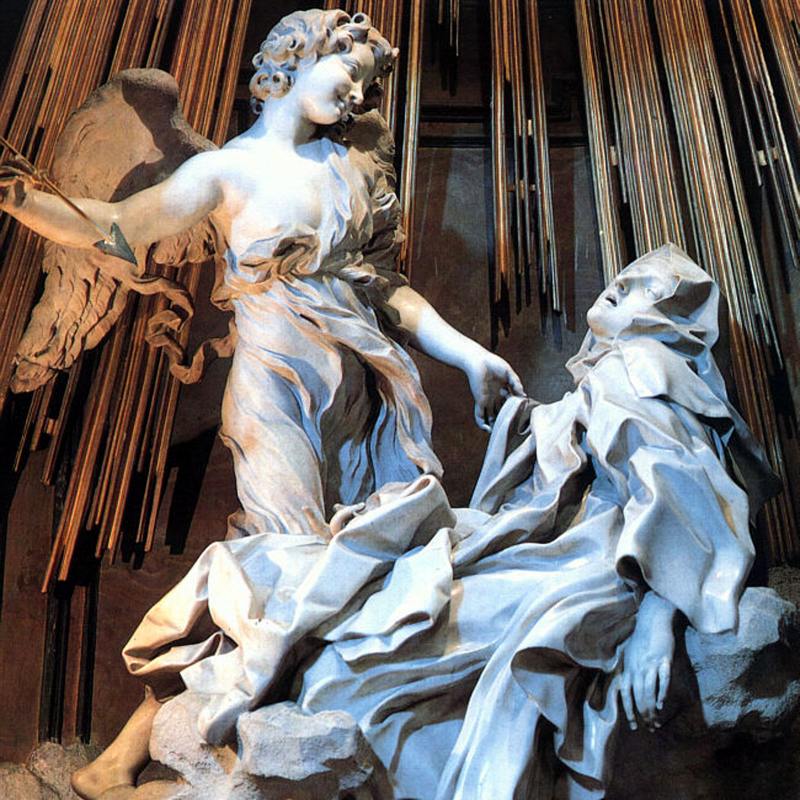Freud distinguished between two basic experiences of the psychic apparatus: one is the experience of satisfaction (1905;1920), and the second is of pain (1895). In his Project for a Scientific Psychology (1895), Freud identified the phenomenon of pain as one that comes along with a biological-physical process that has reached the limit of its efficiency. As he often did, he used biology to describe pain as an excess that disturbs, and as a cause of a marked increase in the amount of neuronal stimulation, which is experienced as unpleasant. Namely, the increase in stimulus produces sensory excitement and ultimately pain. Freud wrote that sometimes pain is associated with protection against the continuity of bodily movement.
Lacan described pain while referring to the architecture of the Baroque. The Baroque is the title given to a trend in architecture, art, dance and literature that dominated in the 16th-18th centuries. This trend was characterized by complexity, merging contrasts, movement and drama. One of the most well-known Baroque artists is Giovanni Lorenzo Bernini, some of whose sculptures dealt with pleasure and female sexuality and tried to capture the climax of the sexual act and the moment of ecstasy. The Baroque epoch interested Lacan and he was most occupied by Bernini’s work on Saint Teresa, placed in the Cornaro Chapel, Santa Maria della Vittoria in Rome, which is considered one of the most famous Baroque works of art.
In at least two seminars of his teaching – Seminar 7, The Ethics of Psychoanalysis (1959-1960), and in Seminar 20, Encore (1972-1973) – Lacan used the architecture of the Baroque to demonstrate how excess pain is trapped in the body without the ability to release it. This architecture highlights the paradox of static stone and vivacity, trapped together. Lacan used this metaphor to describe the mental pain of the tortured. He rejected the idea of pain only as a product of physical sensory activity, and attributed it to a realm of existence, one from which the speaking being, the parlêtre, has no way to escape (Seminar 7). In Seminar 20, Lacan referred his audience specifically to Bernini’s statue of Saint Teresa, which relates to her jouissance: “You only have to get to Rome and look at Bernini’s statue to immediately realize that she enjoys [qu’ elle jouit], there’s no doubt about it. And what is she enjoying?” (1972-1973). It can be concluded from Lacan’s assertions in this seminar that he links pain to feminine jouissance and therefore he attributes to pain something of the order of infinity.
Her experience of religious ecstasy as she encountered the angel is described in her autobiography, The Life of Teresa of Jesus (1515–1582), as follows:
I saw in his hand a long spear of gold, and at the iron’s point there seemed to be a little fire. He appeared to me to be thrusting it at times into my heart, and to pierce my very entrails; when he drew it out, he seemed to draw them out also, and to leave me all on fire with a great love of God. The pain was so great, that it made me moan; and yet so surpassing was the sweetness of this excessive pain, that I could not wish to be rid of it. The soul is satisfied now with nothing less than God. The pain is not bodily, but spiritual; though the body has its share in it.
I found it interesting to understand why Lacan attributed pain to feminine jouissance. And what kind of pain is this?
Phallic jouissance, being bounded by the signifier, is the jouissance of an organ. Jouissance that bears the imprint of speech. Whereas Feminine jouissance, the other jouissance, is not complementary to phallic jouissance, but other in relation to it, excessive, and thus Lacan placed it outside the signifier. This is not genital jouissance or object-oriented jouissance, similar to phallic jouissance. It is jouissance that is not limited by the signifier, it is objectless, it is infinite and it is attributed to a woman or anyone who is in a feminine position. That is to say, all speaking beings, all parlêtres, whether or not they are equipped with biological masculine traits.
Nonetheless, I would like to suggest that pain is a kind of sensory presentation or phenomenon which stands for holding on to the signifier and the jouissance of an organ. While going through the pain in the sense of crossing it, not holding on to it, could suggest time and space which belong to a different kind of time and to the infinite space of feminine jouissance. Thus, the presence of pain, even if experienced as infinite, is located in an organ in the body, and belongs to phallic jouissance. This statement supports the fact that feminine jouissance, when bounded by the sinthome, could be a limit to phallic jouissance and even make it superfluous.
Freud, S., “Project for a Scientific Psychology” (1895), trans. J. Strachey et al., SE Vol. I, pp. 295-387.
Freud, S., “Three Essays on the Theory of Sexuality” (1905), SE Vol. VII.
Freud, S., “Beyond the Pleasure Principle” (1920), SE Vol. VXIII.
Lacan, J., The Seminar of Jacques Lacan, Book VII: The Ethics of Psychoanalysis, trans. D. Porter, New-York/London, Norton, 1992.
Lacan, J., The Seminar of Jacques Lacan, Book XX: Encore, trans. B. Fink, Cambridge: Cambridge, Polity, 1999.
Teresa of Avila (1515-1582), The Life of Teresa of Jesus, Chapter XXIX; Part 17.

